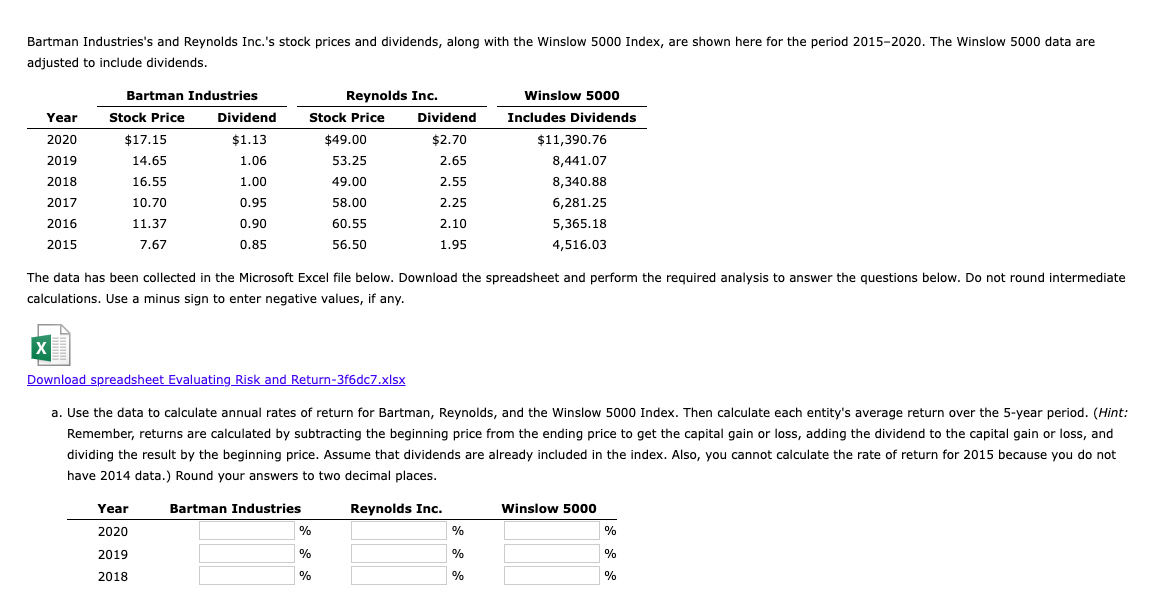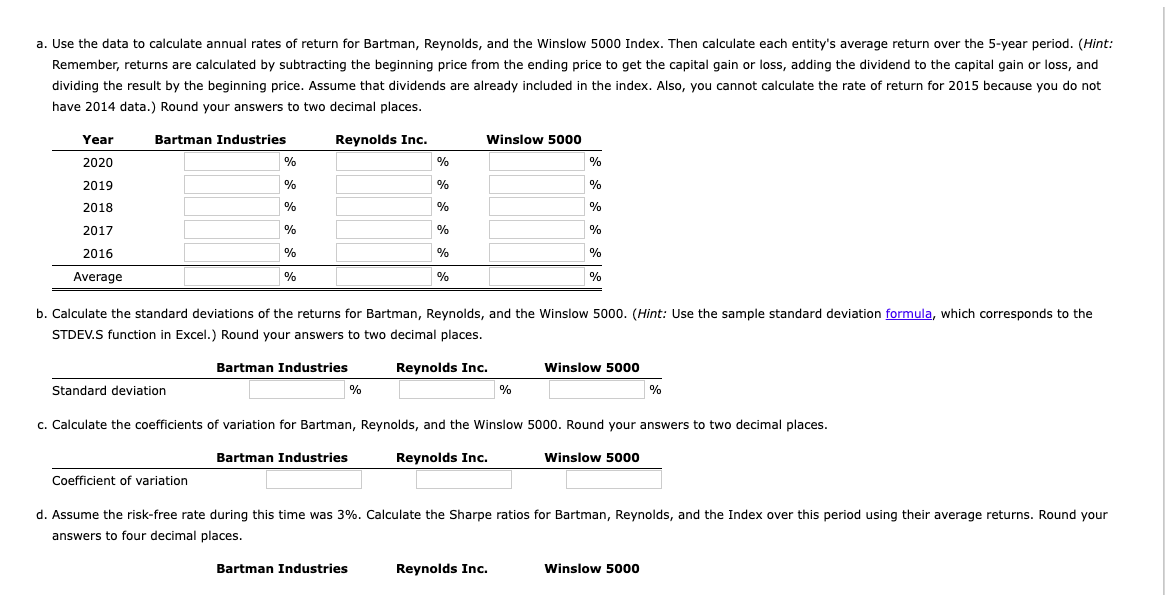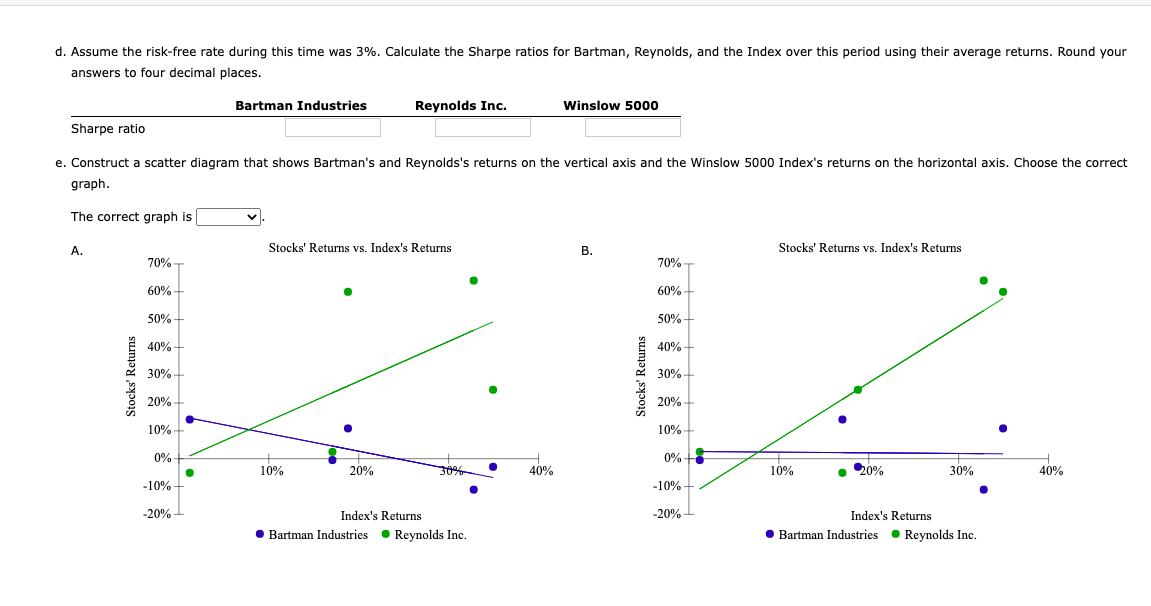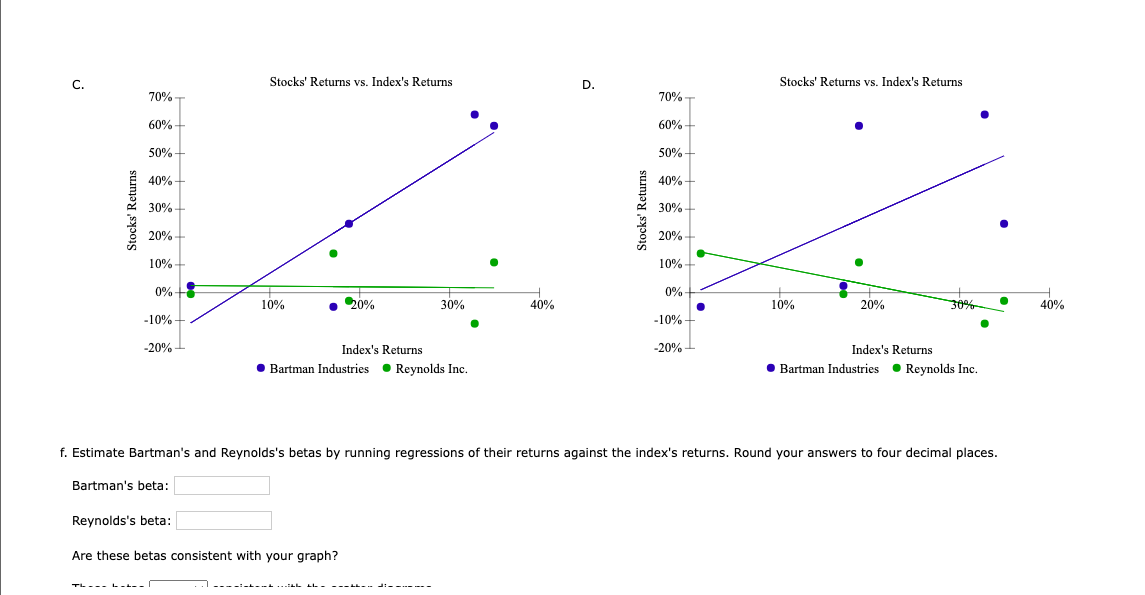


 Please help answer as much as possible with details of steps to understand
Please help answer as much as possible with details of steps to understand
adjusted to include dividends. calculations. Use a minus sign to enter negative values, if any. Download spreadsheet Evaluating_Risk and Return-3f6dc7.x|sx have 2014 data.) Round your answers to two decimal places. a. Use the data to calculate annual rates of return for Bartman, Reynolds, and the Winslow 5000 Index. Then calculate each entity's average return over the 5 -year period. (Hint: Remember, returns are calculated by subtracting the beginning price from the ending price to get the capital gain or loss, adding the dividend to the capital gain or los dividing the result by the beginning price. Assume that dividends are already included in the index. Also, you cannot calculate the rate of 2015 because you do not have 2014 data.) Round your answers to two decimal places. b. Calculate the standard deviations of the returns for Bartman, Reynolds, and the Winslow 5000 . (Hint: Use the sample standard deviation the the STDEV.S function in Excel.) Round your answers to two decimal places. c. Calculate the coefficients of variation for Bartman, Reynolds, and the Winslow 5000. Round your answers to two decimal places. d. Assume the risk-free rate during this time was 3%. Calculate the Sharpe ratios for Bartman, Reynolds, and the Index over this period using their average returns. Round your answers to four decimal places. Bartman Industries Reynolds Inc. Winslow 5000 d. Assume the risk-free rate during this time was 3%. Calculate the Sharpe ratios for Bartman, Reynolds, and the Index over this period using their average returns. Round your answers to four decimal places. s e. Construct a scatter diagram that shows Bartman's and Reynolds's returns on the vertical axis and the Winslow 5000 Index's returns on the horizontal axis. Choose the correct graph. The correct graph is f. Estimate Bartman's and Reynolds's betas by running regressions of their returns against the index's returns. Round your answers to four decimal places. Bartman's beta: Reynolds's beta: Are these betas consistent with your graph? adjusted to include dividends. calculations. Use a minus sign to enter negative values, if any. Download spreadsheet Evaluating_Risk and Return-3f6dc7.x|sx have 2014 data.) Round your answers to two decimal places. a. Use the data to calculate annual rates of return for Bartman, Reynolds, and the Winslow 5000 Index. Then calculate each entity's average return over the 5 -year period. (Hint: Remember, returns are calculated by subtracting the beginning price from the ending price to get the capital gain or loss, adding the dividend to the capital gain or los dividing the result by the beginning price. Assume that dividends are already included in the index. Also, you cannot calculate the rate of 2015 because you do not have 2014 data.) Round your answers to two decimal places. b. Calculate the standard deviations of the returns for Bartman, Reynolds, and the Winslow 5000 . (Hint: Use the sample standard deviation the the STDEV.S function in Excel.) Round your answers to two decimal places. c. Calculate the coefficients of variation for Bartman, Reynolds, and the Winslow 5000. Round your answers to two decimal places. d. Assume the risk-free rate during this time was 3%. Calculate the Sharpe ratios for Bartman, Reynolds, and the Index over this period using their average returns. Round your answers to four decimal places. Bartman Industries Reynolds Inc. Winslow 5000 d. Assume the risk-free rate during this time was 3%. Calculate the Sharpe ratios for Bartman, Reynolds, and the Index over this period using their average returns. Round your answers to four decimal places. s e. Construct a scatter diagram that shows Bartman's and Reynolds's returns on the vertical axis and the Winslow 5000 Index's returns on the horizontal axis. Choose the correct graph. The correct graph is f. Estimate Bartman's and Reynolds's betas by running regressions of their returns against the index's returns. Round your answers to four decimal places. Bartman's beta: Reynolds's beta: Are these betas consistent with your graph



 Please help answer as much as possible with details of steps to understand
Please help answer as much as possible with details of steps to understand





